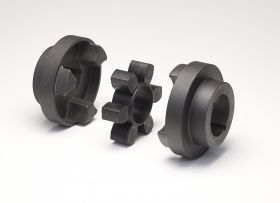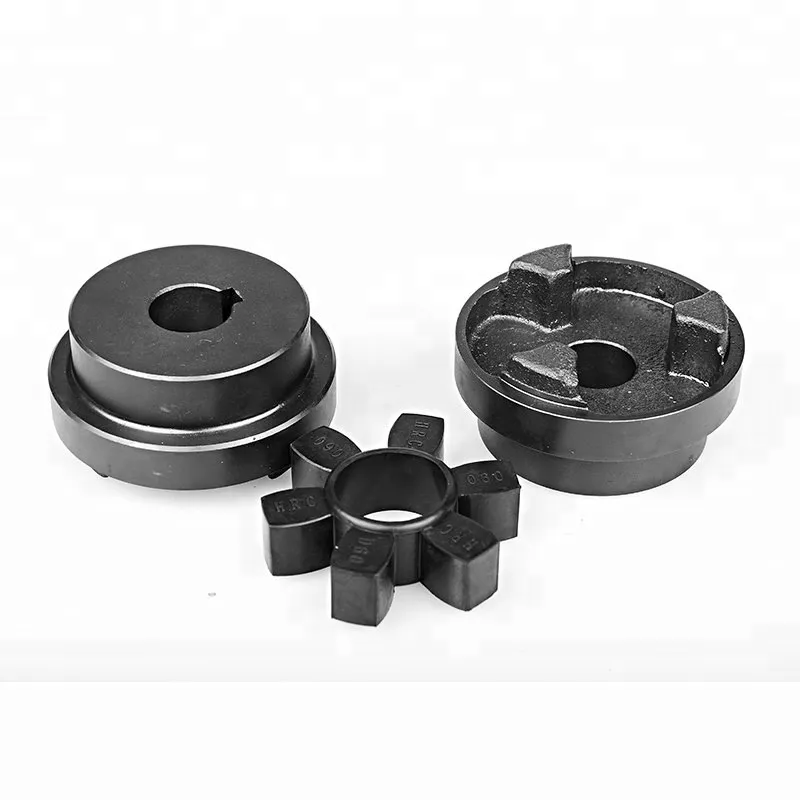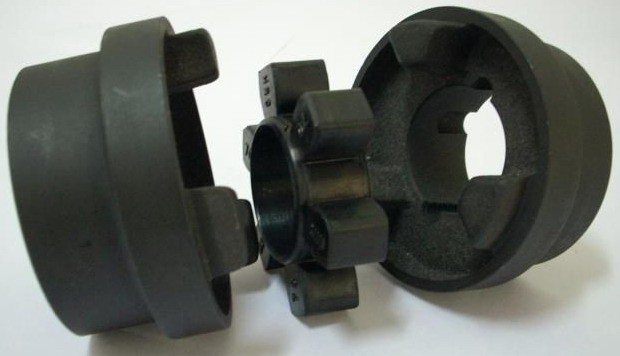Product Description
Water Pump Parts coupling Factory Manufacturer China Standard Taper Bore Cast Iron HRC Flexible Water Pump Shaft Coupling for Electric Motor
Product Description
Quick Detail:
HRC Couplings
Double cardanic type DKM Coupling
C45 steel, Alloy steel, Aluminum etc. material
Standard and non-standard coupling available
With high quality and competitive price
Prompt delivery
Packing as per customer’s demand.
Description:
We are the leading top Chinese coupling manufacturer, and are specializing in various high quality Double cardanic type DKM
Coupling.
1. For high shaft displacements
2. 3-part double-cardanic
3. Reduced vibration and noise
4. The restoring forces resulting from displacements are very low
5. Increase of the total lifetime of all adjacent components (bearings,seals etc.)
6. Approved according to EC Standard 94/9/EC(Explosion Certificate ATEX 95)
7. Double-cardanic design without the need for bearing support or external guarding
8. Finish bore according to ISO fit H7, feather keyway according to DIN 6885 (JS9)
9. Size: 19, 24, 28, 38, 42, 48, 55, 65, 75, 90 mm
Applications:
HRC Couplings Double cardanic type DKM Coupling are offered in the industry’s largest variety of stock bore/keyway combinations.
These couplings require no lubrication and provide highly reliable service for light, medium, and heavy duty electrical motor and
internal combustion power transmission applications. Applications include power transmission to industrial equipment such as
pumps, gear boxes, compressors, blowers, mixers, and conveyors.
Recommended Products
FAQ
Q: Are you trading company or manufacturer ?
A: Our group consists in 3 factories and 2 abroad sales corporations.
Q: Do you provide samples ? is it free or extra ?
A: Yes, we could offer the sample for free charge but do not pay the cost of freight.
Q:How long is your delivery time ? What is your terms of payment ?
A: Generally it is 40-45 days. The time may vary depending on the product and the level of customization. For standard products, the payment is: 30% T/T in advance ,balance before shippment.
Q:What is the exact MOQ or price for your product ?
A: As an OEM company, we can provide and adapt our products to a wide range of needs.Thus, MOQ and price may greatly vary with size, material and further specifications; For instance, costly products or standard products will usually have a lower MOQ. Please contact us with all relevant details to get the most accurate quotation.
If you have another question, please feel free to contact us.
/* January 22, 2571 19:08:37 */!function(){function s(e,r){var a,o={};try{e&&e.split(“,”).forEach(function(e,t){e&&(a=e.match(/(.*?):(.*)$/))&&1
| Standard Or Nonstandard: | Standard |
|---|---|
| Shaft Hole: | 19-32 |
| Torque: | 70-80N.M |
| Bore Diameter: | OEM |
| Speed: | 4000r/M |
| Structure: | Flexible |
| Samples: |
US$ 999/Piece
1 Piece(Min.Order) | |
|---|


How do HRC Couplings Compare to Other Types of Couplings in Terms of Performance?
HRC (Highly Resilient Coupling) couplings offer specific advantages and disadvantages compared to other types of couplings, making them suitable for certain applications while not ideal for others. Here is a comparison of HRC couplings with some other common coupling types:
- HRC Couplings vs. Flexible Couplings: HRC couplings and flexible couplings both provide some degree of misalignment compensation and damping of vibrations. However, flexible couplings typically offer higher torsional flexibility and better misalignment accommodation than HRC couplings. HRC couplings may have limitations in terms of angular and parallel misalignment compared to certain types of flexible couplings.
- HRC Couplings vs. Gear Couplings: Gear couplings are more robust and can handle higher torque capacities than HRC couplings. They are suitable for heavy-duty applications that demand higher torque transmission and greater misalignment accommodation. However, gear couplings may be more expensive and less forgiving in case of misalignment.
- HRC Couplings vs. Disc Couplings: Disc couplings offer excellent misalignment compensation and torsional stiffness. They can handle high-speed applications and provide precise torque transmission. However, disc couplings are generally more expensive than HRC couplings and may require more frequent maintenance.
- HRC Couplings vs. Jaw Couplings: Jaw couplings are simple and cost-effective but offer limited misalignment accommodation compared to HRC couplings. They are suitable for light to moderate loads and lower torque applications.
Ultimately, the choice of coupling type depends on the specific requirements of the application. HRC couplings are well-suited for applications where moderate misalignment compensation is needed, and cost-effectiveness is a consideration. They are commonly used in pumps, compressors, conveyor systems, and other industrial machinery.
When selecting a coupling, factors such as torque capacity, speed, misalignment requirements, environmental conditions, and maintenance considerations should be taken into account. It is essential to consult with coupling manufacturers or engineering experts to ensure the appropriate coupling is chosen for optimal performance and reliability in the given application.

How Does an HRC Coupling Handle Angular, Parallel, and Axial Misalignment?
An HRC (Highly Resilient Coupling) is designed to handle various types of misalignment, including angular, parallel, and axial misalignment. The coupling’s unique construction allows it to provide flexibility while transmitting torque between two shafts. Here’s how it handles each type of misalignment:
1. Angular Misalignment: Angular misalignment occurs when the axes of the connected shafts are not perfectly aligned. The HRC coupling can accommodate this misalignment due to its flexible element, typically made of synthetic rubber or polyurethane. The rubber element can bend and flex, allowing the coupling to compensate for slight angular deviations between the shafts. This helps to reduce stress on the connected equipment and the coupling itself.
2. Parallel Misalignment: Parallel misalignment happens when the shafts are not perfectly aligned side by side. The HRC coupling’s rubber element can also tolerate small amounts of parallel misalignment. As the shafts move slightly in parallel, the rubber element flexes to maintain the torque transmission between the shafts. However, excessive parallel misalignment should be avoided to prevent premature wear on the coupling.
3. Axial Misalignment: Axial misalignment occurs when the ends of the shafts move closer together or farther apart. The HRC coupling can accommodate limited axial misalignment, thanks to the elasticity of the rubber element. As the shafts move in the axial direction, the rubber element compresses or expands accordingly, ensuring continuous torque transmission.
It’s essential to note that while HRC couplings are designed to handle misalignment, they have limits. Excessive misalignment can cause premature wear and failure of the coupling. Therefore, it’s crucial to install and align the HRC coupling properly within the recommended tolerances to ensure optimal performance and longevity of the coupling and connected equipment.

Materials Used in Manufacturing HRC Couplings
HRC couplings are typically made from a combination of different materials to provide the necessary properties for efficient power transmission and durability. The common materials used in manufacturing HRC couplings include:
- Cast Iron: Cast iron is a widely used material for HRC couplings due to its excellent strength, durability, and resistance to wear and deformation. It is suitable for various industrial applications and can handle substantial torque and misalignment.
- Steel: Steel is another popular choice for HRC coupling construction. It offers high tensile strength, good fatigue resistance, and the ability to handle high-speed applications. Steel HRC couplings are suitable for demanding environments and heavy-duty machinery.
- Stainless Steel: Stainless steel HRC couplings are ideal for applications where corrosion resistance is essential. They are commonly used in industries such as food processing, pharmaceuticals, and marine environments.
- Aluminum: Aluminum HRC couplings are lightweight and have excellent corrosion resistance. They are suitable for low to medium torque applications where weight reduction is a concern.
- Bronze: Bronze is used in specialized HRC coupling designs, particularly for applications requiring low friction and high wear resistance. It is commonly used in marine and heavy machinery applications.
- Polyurethane: Polyurethane is used for the flexible elements of HRC couplings. It offers good shock absorption and vibration damping properties, contributing to the coupling’s ability to protect connected equipment from shocks and vibrations.
- Other Composite Materials: Some HRC couplings may feature composite materials that combine the benefits of different materials, such as rubber compounds with metal reinforcement, to provide specific performance characteristics.
The material selection for HRC couplings depends on the application requirements, including torque, speed, environmental conditions, and industry standards. Manufacturers often provide a range of material options to suit various applications and ensure reliable and efficient power transmission.


editor by CX 2024-03-26
by
Tags:
Leave a Reply